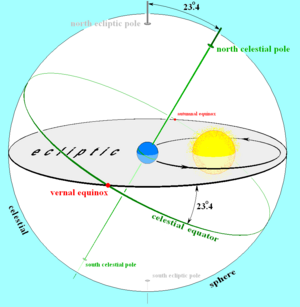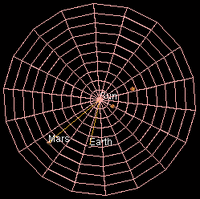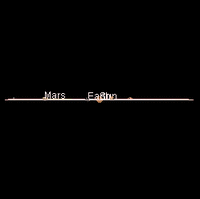Ecliptic facts for kids
The ecliptic is like an imaginary path that the Sun seems to follow in the sky throughout the year. As our Earth orbits the Sun, the Sun appears to move against the background of stars. This apparent path is the ecliptic. It's also where you'll often see the planets, because they orbit the Sun in a similar flat area.
The word "ecliptic" comes from eclipses. This is because eclipses happen when the Moon or Earth crosses this special path.
Contents
How the Sun Seems to Move
The Sun's apparent movement along the ecliptic is due to Earth orbiting the Sun. It takes Earth about one year to complete its orbit. This means the Sun appears to travel along the entire ecliptic in one year.
Since there are a little more than 365 days in a year, the Sun seems to move almost 1 degree eastward each day. This small daily shift is why a day on Earth is 24 hours long. If Earth didn't orbit the Sun, a day would be slightly shorter, about 23 hours and 56 minutes.
The speed at which Earth orbits the Sun changes a little during the year. This means the Sun also seems to move at slightly different speeds along the ecliptic. For example, the Sun is north of the celestial equator for about 185 days each year. It is south of it for about 180 days.
Ecliptic and Earth's Tilt

Earth's rotational axis is not straight up and down compared to its orbit. It's tilted by about 23.4 degrees. This tilt is called the obliquity of the ecliptic. Because of this tilt, Earth's equatorial plane is not flat with the ecliptic plane.
If you imagine Earth's equator stretching out into space, it forms the celestial equator. The celestial equator crosses the ecliptic at two special points called the equinoxes. When the Sun appears to move along the ecliptic, it crosses the celestial equator at these points.
One crossing is from south to north, called the vernal equinox (or spring equinox). The other crossing is from north to south, called the autumnal equinox. These crossings mark the start of spring and autumn.
Earth's tilt and the ecliptic are not perfectly still in space. They slowly wobble and shift over thousands of years. This slow wobble is called precession. It's mostly caused by the Moon and Sun pulling on Earth's slightly bulging middle. This changes the exact position of the equinoxes over time.
The Solar System's Flat Plane
Most of the big objects in our Solar System, like the planets, orbit the Sun in a very flat, disk-like area. This is probably because the Solar System formed from a flat spinning cloud of gas and dust.
The ecliptic, which is Earth's orbital plane, is very close to this main flat plane of the Solar System. The other major planets are also within about 6 degrees of it. This is why you often see planets appearing close to the ecliptic line in the sky.
The ecliptic is a useful reference plane for astronomers. It helps them understand where objects are in the sky.
 |
 |
 |
| These pictures show the plane of the ecliptic from above and the side. They show how planets like Mercury, Venus, Earth, and Mars orbit the Sun almost in the same flat area as Earth. | Here are four planets lined up along the ecliptic in July 2010. This photo shows how planets orbit the Sun in nearly the same flat plane. It was taken at sunset in Indonesia. | |
Images for kids
See also
 In Spanish: Eclíptica para niños
In Spanish: Eclíptica para niños



